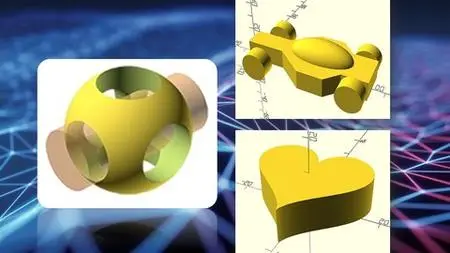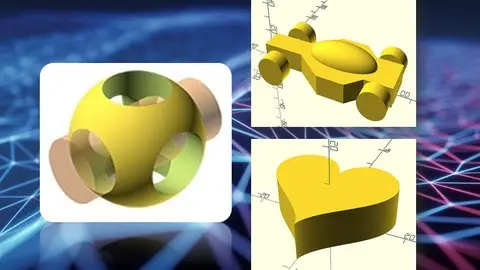Learning And Practicing Openscad On 3D Modeling
Published 4/2024
MP4 | Video: h264, 1920x1080 | Audio: AAC, 44.1 KHz
Language: English | Size: 7.44 GB | Duration: 10h 52m
Published 4/2024
MP4 | Video: h264, 1920x1080 | Audio: AAC, 44.1 KHz
Language: English | Size: 7.44 GB | Duration: 10h 52m
Learn to use OpenSCAD to create solid 3D CAD objects through hands-on tutorial
What you'll learn
Get to know and familiar OpenSCAD software
Understand and grasp the key programming approach for 3D modeling
Learn by practicing of building 3D model via programming/coding
Able to build variable 2D/3D shapes through following the hands-on demo
Well prepared for further 3D modeling and 3D printing field
Requirements
Basic programming knowledge, no specific language required
Description
OpenSCAD is open source software for creating solid 2D/3D CAD objects., it's free and available for Linux/UNIX, MS Widnows and Mac OS X.OpenSCAD is software for creating solid 3D CAD models. It is free software and available for Linux/UNIX, Windows and Mac OS X. Unlike most free software for creating 3D models (such as Blender) it does not focus on the artistic aspects of 3D modelling but instead on the CAD aspects. Thus it might be the application you are looking for when you are planning to create 3D models of machine parts but pretty sure is not what you are looking for when you are more interested in creating computer-animated movies.OpenSCAD is not an interactive modeller. Instead it is something like a 3D-compiler that reads in a script file that describes the object and renders the 3D model from this script file. This gives you (the designer) full control over the modelling process and enables you to easily change any step in the modelling process or make designs that are defined by configurable parameters.OpenSCAD provides two main modelling techniques: First there is constructive solid geometry (aka CSG) and second there is extrusion of 2D outlines. Autocad DXF files can be used as the data exchange format for such 2D outlines. In addition to 2D paths for extrusion it is also possible to read design parameters from DXF files. Besides DXF files OpenSCAD can read and create 3D models in the STL and OFF file formats.This course aims to provide you detail guides and demos base on formal OpenSCAD tutorial, shows every single detail of coding with thorough explanation.After the course, you'll be able to use OpenSCAD to design and build creative 3D CAD objects, and be able to enroll my next level course – "Mastering OpenSCAD in 10 Projects". Enjoy!
Overview
Section 1: Opening, Introduction and Initialization
Lecture 1 Opening and Introduction
Lecture 2 Download and Install OpenSCAD (Windows OS)
Section 2: OpenSCAD Tutorial - Chapter 1
Lecture 3 Chapter 1 - Part 1
Lecture 4 Chapter 1 - Part 2
Section 3: OpenSCAD Tutorial - Chapter 2
Lecture 5 Chapter 2 - Part 1 - Scaling Parts
Lecture 6 Chapter 2 - Part 2 - Parameterizing
Section 4: OpenSCAD Tutorial - Chapter 3
Lecture 7 Chapter 3 - Part 1 - Sphere & Resizing
Lecture 8 Chapter 3 - Part 2 - Combining Objects
Lecture 9 Chapter 3 - Part 3 - Update Car Model
Section 5: OpenSCAD Tutorial - Chapter 4
Lecture 10 Chapter 4 - Part 1 - Defining Modules
Lecture 11 Chapter 4 - Part 2 - Parameterizing Modules
Lecture 12 Chapter 4 - Part 3 - Default Values in Modules
Lecture 13 Chapter 4 - Part 4 - Separating Model into Modules
Section 6: OpenSCAD Tutorial - Chapter 5
Lecture 14 Chapter 5 - Part 1 - Modules as Separate Scripts
Lecture 15 Chapter 5 - Part 2 - Script with Multiple Modules
Lecture 16 Chapter 5 - Part 3 - Use MCAD Library
Lecture 17 Chapter 5 - Part 4 - More Parameterizable Modules
Section 7: OpenSCAD Tutorial - Chapter 6
Lecture 18 Chapter 6 - Part 1 - OpenSCAD Variables
Lecture 19 Chapter 6 - Part 2 - Conditional Variables
Lecture 20 Chapter 6 - Part 3 - More Conditional Variable Assignment
Lecture 21 Chapter 6 - Part 4 - Conditional Creation - IF Statement
Lecture 22 Chapter 6 - Part 5 - Update Car Model by Variables Usage
Section 8: OpenSCAD Tutorial - Chapter 7
Lecture 23 Chapter 7 - Part 1 - FOR Loops
Lecture 24 Chapter 7 - Part 2 (1) - More Complex Patterns - Car Circle
Lecture 25 Chapter 7 - Part 2 (2) - More Complex Patterns - Spoked_Wheel
Lecture 26 Chapter 7 - Part 2 - More Complex Patterns - Car with Spoked_Wheels
Lecture 27 Chapter 7 - Part 3 - Nested FOR Loops
Section 9: OpenSCAD Tutorial - Chapter 8
Lecture 28 Chapter 8 - Part 1 - Rotationally Extruding 3D Objects from 2D Objects
Lecture 29 Chapter 8 - Part 2 - Rotationally Extruding on Wheels
Lecture 30 Chapter 8 - Part 3 - Linearly Extruding 3D Objects from 2D Objects
Lecture 31 Chapter 8 - Part 4 - Car with Rounded Body from 2D Extruding
Section 10: OpenSCAD Tutorial - Chapter 9
Lecture 32 Chapter 9 - Part 1 - Math Calculations
Lecture 33 Chapter 9 - Part 2 - Polygon 2D Object
Lecture 34 Chapter 9 - Part 3 - Racing Car Body
Lecture 35 Chapter 9 - Part 4 - Create "Heart" - No. 1
Lecture 36 Chapter 9 - Part 4 - Create "Heart" - No.2
Lecture 37 Chapter 9 - Part 5 - Aerodynamic Spoiler for Racing Car
Anyone interests on 3D printing,Anyone interests of building hands-on 2D / 3D shapes,Anyone interests on learn new tool for building 3D CAD models via coding



